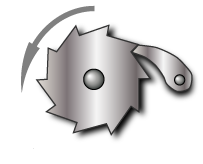I was just testing out the Olympus OM-2 shutter when I notices that the multi-stroke advance lever sometimes slipped. Now I have read online that many Olympus users do have to advance the lever a couple of times to charge the shutter, but this one sometimes free flows.
So lets take a look.
I took the top off … again … to get a closer look at the gearing.

Ok, so what do we see here … ignore that dark gear on the bottom, we are interested in the brass one just above it. If you look carefully you will see that the teeth are worn.

This is a pawl mechanism, as you push the advance lever a pawl engages a tooth in the ratchet gear and turns it. With the OM-2 the pawl revolves, with the advance lever, to turn the ratcheted gear. If it does not engage the first tooth, the advance lever will return, and then you will need to advance further, engaging the ratcheted gear again to get to the end of the cycle.
If the advance lever is really forced it will cause the pawl to slip out of the tooth … which will cause wear on both edges that are engaging … eventually over time you can wear both down so that they no longer have a grip.
I pulled out the component to see if I could get a better look … just remove the three screws on top … sadly I took a picture of the wrong side for you all.
You can see the dark gear on the bottom … and the pawl mechanism above it.
This camera has dual pawls that are not spring loaded. They appear to engage the ratchet by some light pushing force when the advance is turned.
Without taking everything apart, I just used a fine file to put more of an edge on one side of the pawls tooth … this did help a bit … the real solution is to replace both ratchet gear and both pawls … or possibly take it apart and use a Dremel to reshape the tooth?
Well, just have to live with a really multi-stroke advance.
… and remember, if you cannot advance the the winding lever using the Force to get to the end is not the solution. Winding levers don’t tend to get stuck for no reason !!!






 After his success with the Olympus Pen camera and Zuiko lenses, Yoshihisa was the chief camera designer and in 1967 endeavored to make a full-frame 35mm SLR. Like the Pen, he wanted something smaller, quieter, better than all those other SLR’s out there … it also needed to be a versatile system of lenses and accessories designed around it to be able to take pictures of everything.
After his success with the Olympus Pen camera and Zuiko lenses, Yoshihisa was the chief camera designer and in 1967 endeavored to make a full-frame 35mm SLR. Like the Pen, he wanted something smaller, quieter, better than all those other SLR’s out there … it also needed to be a versatile system of lenses and accessories designed around it to be able to take pictures of everything.
 The F means the lens has … hmm, ABCDEF … 6 elements. It’s always handy to hunt down an illustration of the elements and groups, cause if you put them in the wrong order or flip one of them around, you ain’t got much of a good lens.
The F means the lens has … hmm, ABCDEF … 6 elements. It’s always handy to hunt down an illustration of the elements and groups, cause if you put them in the wrong order or flip one of them around, you ain’t got much of a good lens. From the back first … just to be different.
From the back first … just to be different.

 The inner ring pulls off.
The inner ring pulls off. You can see the holes where the bearing will sit.
You can see the holes where the bearing will sit.
 Note the arm sticking out of one side … that arm couples with the aperture ring.
Note the arm sticking out of one side … that arm couples with the aperture ring.

 Here is where you should remember to look back at the first image in this post.
Here is where you should remember to look back at the first image in this post.